The Suicide Survivor’s Guide to Crafts
Joshua Adair
Within hours of discovering his suicide—in a fugue state of absolute shock—I baked and delivered a loaf of bread to my partner's mother, knowing that she must be abject with grief and despair. I did it because I didn't know what else to do and making and giving come naturally to me, and also because I'm a Midwesterner whose mother taught me that's how we manage grief. This essay delves into the aftermath of suicide, crafting as a mode of survival, and the generative, though not necessarily redemptive, power of grief intermingled with a desire to create.
“She looks like she makes her own clothes!”—my mother’s unkind shorthand phrase for female unattractiveness—leapt into my brain as I caught sight of my ersatz mother-in-law at my partner’s funeral, which was her very own invitation-only, DIY affair. Judging from her denim jumper, floral cotton t-shirt, and green garden clogs, I assumed she’d decided to dig the hole and plant him herself. Sadly, that didn’t turn out to be the case, though she gave an excellent impression of scaling a trellis to trim a climber as her diminutive 5-foot frame mounted the casket and ripped roses from its spray. She even sent her brother-in-law to ask if I’d like one, too. I replied that I would, and without missing a beat he said, “well then go get one,” as I stood under the oppressive August sun in what seemed like 1000% humidity, weeping uncontrollably, and wondering if I’d slipped into a dark Laurel and Hardy routine.

Aaron, my partner, at age 26
As we left the cemetery, his mother lamented her ignorance about drying flowers, fearing she couldn’t preserve the fruits of her climb. Crafty queer that I am, I automatically responded, “you have two options. Either buy some silica sand and submerge it till it’s crisp, or wrap the stem in floral wire and hang it upside down till it’s dry.” In that instant something clicked—I saw it cross her face—because she’d discovered how to forge a connection with me, a man she barely knew despite my relationship with her son. We had kept our respective distance, you see, when he was still alive, and our shared grief forced us together because neither of us had anyone else.
We spent the next year crafting together under extreme duress, that process its own productive lamentation of the son and partner we’d respectively lost to suicide. In the process, too, we each constructed one-dimensional versions of the other which are neither fair nor terribly representative of who we are as people. The reasons for this are quite simple and incredibly complex: we were essentially strangers at the time of his suicide, having actively elected to remain unknown to one another during his life; we each needed comforting in the search for an explanation to satisfy the unanswerable and there was no one else to whom we could turn; we both needed a villain, if only as a distraction, upon whom we could focus our energies to survive. I was hers and she mine.
We embodied many of the ugly stereotypes of spouses and in-laws so fully at points that each of us fashioned ourselves, albeit unwittingly, I believe, into caricatures that will undoubtedly strike you as petty and mean, even lacking dimension, and to this charge I would say that you’re correct and then I would follow my assent by saying that crafting my mother-in-law as a parodic figure facilitated my ability to negotiate my first year of mourning. The people I depict here are real to me in the sense that they authentically and accurately represent the past I lived as I perceived it in the haze of an emotional maelstrom, but they are also the fictive figments of a past heavily shaded by grief, despair, and anger and for that reason should not be taken as literal or objective.
I am, without a doubt, unkind and ungenerous in my representations here; we rendered one another as rivalrous villains, even worthy adversaries, to cope with the unthinkable. Strange as it may sound, I would welcome a similarly unflattering depiction from her, because that is who we were then. Had we met under different circumstances we might conceive one another as utterly different people and in the intervening years, our feelings toward one another have softened somewhat. We are not great friends, but I have cared enough about her and her loss to maintain a relationship for well over a decade now—one strong enough that we can at the very least smirk at our initial characterizations of one another. I focus on that year and its angry subjectivities, in all its bias and myopia, because it was the year we crafted.
I suppose at some point Aaron had shared with his mother that I enjoyed and had a facility for making things as that was one of the things that drew us together initially. He liked to work on watches and make jewelry and generally tinker with things. I grew up in the midst of never-ending making, courtesy of parents who always quipped that if we had enough money to buy the supplies for something that there was never enough to hire someone to do it.
Crafting, for us, was both survival and pleasure because we had little money and a desire for nice things. I never drove a car produced after 1965 until I was in my twenties because my dad focused much of his DIY energy upon restoring classic cars, so I learned how to make a 1955 Chevrolet Bel-Air cool. I never ate a school lunch or tried a lot of popular junk food because my mother made and packed our lunches. At various points in our childhood she made jointed fur teddy bears, sculpted dolls, and various other creatures to sell for extra cash.
My parents were, and still are, inveterate remodelers and restorers. During a recent visit to my new house, my dad and I installed a direct-vent fireplace, leveled sagging floors, and repaired two air conditioners in the space of a few days. This is our modus vivendi: we see crafting and DIY as modes of self-reliant independence and self-preservation, not a hip pastime or hot trend. If we don’t know how to do something, we aim to learn how rather than hiring help. Aaron wasn’t quite that obstinate about it, but he liked my style in that regard.

The fireplace my dad and I
recently installed.
Crafting, especially, has also been a means to build relationships and seize some measure of power for me. Although it sounds fairly trite, cliché even, I was a feminine kid who was more interested in learning to embroider than in learning to ride a motorcycle. I was a gay stereotype before I even knew what that was, making evergreen topiaries at Christmas and flavoring vinegars with the herbs I’d grown to give as gifts before I’d even entered high school. As a kid, engaging in these activities largely got me ostracized and bullied and once I finally grasped that crafting was considered feminine and completely unacceptable for boys and men—sometime in early high school—I abandoned these pastimes for a while.
Later, though, as an adult I returned to making things—everything from drapes to furniture—because it felt natural to me and I have always wanted beautiful things I couldn’t afford. I had been reading home decoration magazines since I was about twelve years old and their rhetoric permeated my brain. I wanted a life that resembled those magazines and I have always worked to get it. In the process, I discovered that adult friends responded quite differently to a friend with a gorgeous home, gourmet food, and handmade object. Rather than reviling me, they wanted to be a part of my constellation. Suddenly what had once marginalized me gave me great social cache; people seemed to love being around someone who could design, restore, and create. What I also learned is that while people may be drawn to those abilities, the vast majority simply aren’t willing to put forth that effort themselves and my determination helped me shine in that arena by helping me feel empowered and unusual.
Aaron’s mother opted to engage me as a crafter because she knew a little about crafts herself and it was one of our few shared interests. Our relationship—which can only be described as highly complicated—employed craft as a way to establish a connection, to fashion our own little community of two. This community-building was not foreign to me as I’d often formed relationships working in such a manner on various projects throughout my life. It also involved domination, though: each of us was on a quest to prove our superiority over the other by way of our skills at crafting.
We were both skilled, without question, but focusing on “winning” those laurels masked the actual competition, which was to prove who had loved her son best. For me, it was also about struggling with femininity and its connection to craft. She wanted me simultaneously to be her quasi-daughter-in-law, but also to ridicule me for knowing how to do “girls’ things.” While I love femininity far more than I ever will masculinity, we enjoy a fraught relationship, femininity and me, because it has always made me a target for attacks, bullying, and marginalization. She was quite invested in relying upon traditional stereotypes about queers and in her mind I only made sense as her masculine son’s wife in this scenario.
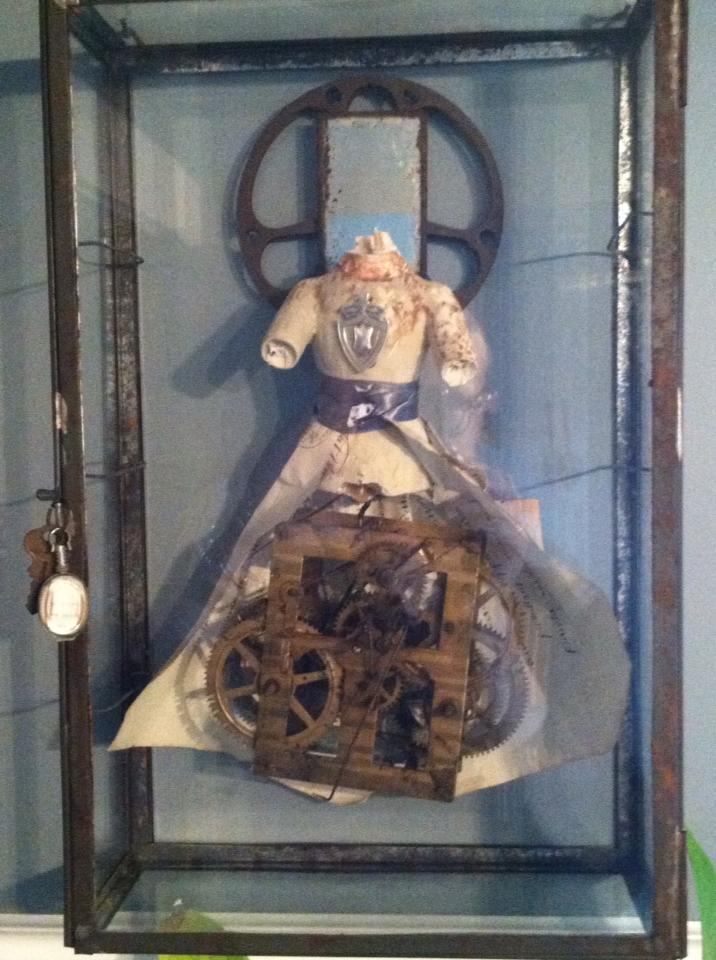
An assemblage I made with an antique
clock movement and an old film reel.
Ironically, I think construing me as such made it easier to discount my worth and impact in his life and as a person—despite the fact that she loved about herself the very things she disliked in me—and I think if I’d been a female crafter things would have gone quite differently because for her traditional gender roles trump creative skill. I resented her indirectly making fun of me for being feminine and engaging in “unmanly” activities, but rather than abandoning these activities that I loved I decided to put her in her place with my crafting prowess. People rarely recognize or interrogate the intensely competitive nature of some crafting and its connection to self-worth, of which our story is a perfect illustration. She might demean me or belittle my relationship with her son, but I was intent upon her acknowledging, however grudgingly, my superiority in the realm of craft.
Before that year, we barely knew one another because my partner kept his distance from her most of the time. I knew that she loved to clean and organize and that she tatted extremely well. Her creations proudly proclaim her precise, perfectionistic personality and underline her insistence upon order and tidiness in all things. It should come as no surprise then that the militaristic manner with which she approaches the production of something like tatted snowflakes to hang in a window at Christmas proved completely antagonistic to the case of OCD in her son so severe that the best specialists in the nation declared him a lost cause. After years of battling the illness and attempting to harness its debilitating power into a creative channel so as to disempower it, training as a horologist, a goldsmith, and eventually a machinist of military weapons, he finally committed the ultimate DIY and left his mother frantically wondering how to remove blood from that “beautiful, almost brand-new carpet!” The loss was (and is) a terrible one for her and me, but I appreciate the dark irony of his hands-on approach, especially since he likely made the bullet that did the job.
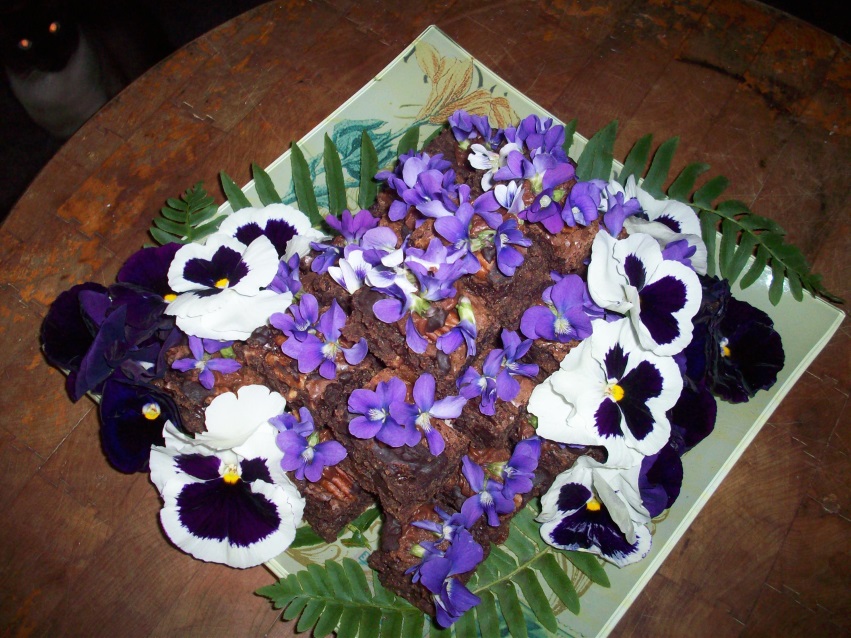
Birthday party brownies
with violets and pansies.
For his mother and me, our crafting journey coalesced out of loss, rivalry, and despair. For a woman who could make anything she set her mind to, she somehow still managed to be mousy and meek in the most overbearing of ways. Cheapness, as she will tell you, is her chief charm—a trait I abhor when not born of necessity—and that was never clearer than in the flower arrangements with which she decorated his grave. She disliked fresh cut flowers—too extravagant and short-lived for her taste, much like her son—so she bought “silk” stems from the Dollar Tree and stuck them in the vases attached on either side of the headstone. One 99 cent bush usually cowered on each side, failing to create the faintest illusion of beauty or care. She changed these offerings seasonally and even attempted to inject holiday flair for Valentine’s Day, Christmas, Easter, even St. Patrick’s Day. She celebrated by adding accessories like glittery red hearts attached to springs that quivered in the breeze like otherworldly tentacles, lending the whole affair a jauntiness both comical and completely incongruous which, even at the best of times, morphed his headstone into something resembling a pair of Dame Edna’s cat-eye glasses or the centerpiece of a very down-and-out Liberace.
We each held the other at least somewhat responsible for his suicide. I didn’t know her well enough to say so directly, so I crafted passive-aggressively and delivered frontal assaults in the form of ostentatious floral arrangements. I would prove I loved him more by creating lavish, beautiful things for him. I scoured Michael’s and Hobby Lobby for ornate urns and other containers to deliver to the cemetery overflowing with flowers. Economizer that she is, she always insisted on taking her flowers and containers home and reusing them. Not me: my philosophy was to create something Belle Watling would have deemed parlor-appropriate and then abandon it.
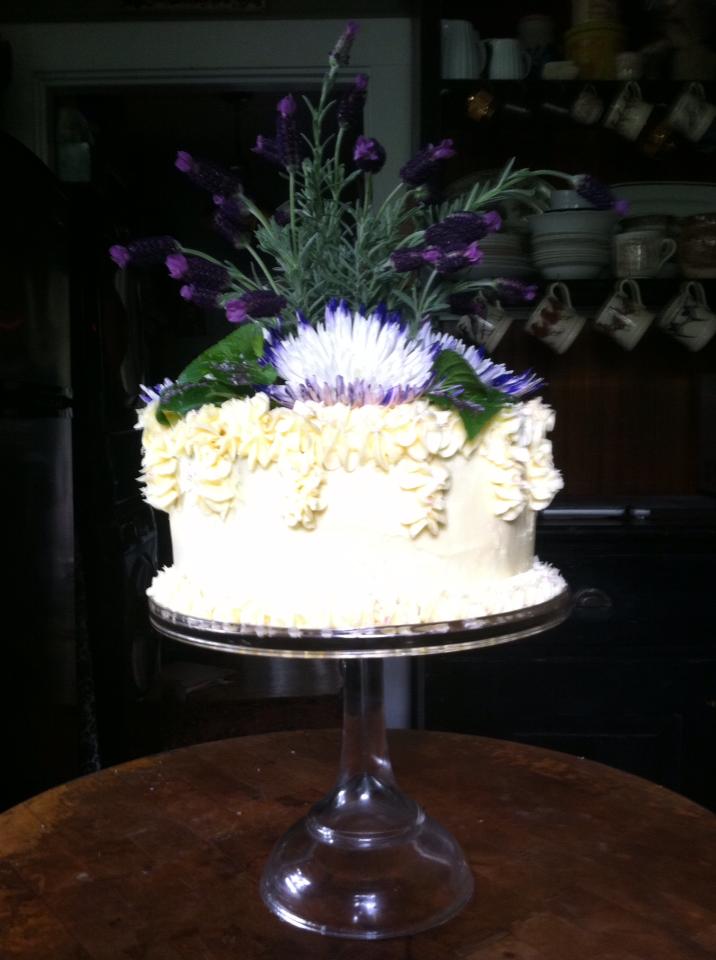
My floral sprays for the cemetery,
like the ones on this Derby cake,
were always quite vertical.
I bought floral foam by the gross and ravaged every flower and bush in my yard. In the off seasons I bought flowers—the most cardinal of all sins to her save procuring ice from a store—and relegated them to a quick death in freezing temperatures. Dozens of red tulips reveled briefly in the snow; pine and holly sprays stood proudly obscuring her meager contributions and most of the headstone; forsythia branches and daffodils mockingly shrieked my floral superiority. Her daily cemetery visits ensured that she never missed a single offering. She couldn’t refuse them outright—and I’m not sure she even wanted to because I suspect some part of her enjoyed the irritation of my persistence—so she repeatedly critiqued my spendthrift ways and tried to return the gaudy containers. I refused them all and mustered every ounce of my crafty energy to produce increasingly elaborate and sizeable arrangements.
The first call came during the bittersweet harvest late that September. She wanted a wreath for her front door but didn’t know how to make one. Debilitated by grief and loneliness, I agreed to join her one afternoon and show her how to make the wreaths I’d been fabricating with my mother since childhood. Her husband had gathered enough bittersweet to fill the bed of his truck, so we spent the afternoon making wreaths and talking. Feigned cluelessness and the indirect assault were her favored methods of trying to learn more about the son she had lost. I played along and withheld what I felt it disloyal to share.
That afternoon, pleasant if stilted, we produced several huge wreaths, one for our respective back and front doors. She expressed elation at my aplomb and satisfaction that she’d learned a new skill. I took genuine pleasure in sharing my knowledge and creating something beautiful. The next time I visited her, though, the bittersweet wreaths on her doors were not mine: they were made-in-China silk imposters purchased from Michael’s. These changelings went unacknowledged by us both, though I knew this was her counterattack for my floral tomfoolery at the cemetery. Or perhaps she wanted to let me know that she found my work wanting, to remind me of her superiority. I comforted myself by imagining that the ones I’d made had entered a witness relocation plan for decorative objects birthed in depressing 1970s split-level houses like hers. Somehow this game of cat-and-mouse buoyed us up, allowing us to stick together while still insisting that our own respective taste reigned supreme.

My new living room, for which I created
many of the pillows, the industrial coffee table,
and various assemblages.
In the following months, she called and emailed frequently, always wanting to work on some new craft together. We polka-dotted pumpkins into luminaries at Halloween; we fashioned cigar-box purses for her to give as Christmas gifts; we monogrammed dishtowels in the dead of winter. I was never particularly happy with our creations as her taste runs to cutesy and mine decidedly does not. Despite our rivalry, there was a strange comfort in working together and talking about the man we loved and missed terribly, though it was always tinged with the suggestion that one of us held back some secret, some revelatory clue.
It was always fraught and often distressing because engaging her perspective about him and his life often proved disturbing; our ideas about what had happened to him were as different as our tastes. I wanted to create things that looked professional, accomplished and she wanted things that looked craftsy and cute like they did in the pages of Family Circle, which I diagnosed as symptomatic of the delusional worldview which rendered her incapable of seeing her son as he was and actually trying to help him. She didn’t want honesty; she wanted the safe illusion of saccharin cuteness.
That winter I amped up my creativity in an attempt to distract myself from my overpowering grief. I decided to teach myself to make decorated layer cakes. We didn’t do this together because she’s no cook—though she fancies herself otherwise—and because she prefers margarine over butter and thinks everything—and I do mean everything—tastes better seasoned with bacon grease. I liked her food as much as I liked her plastic flowers, so I went it alone.
Each Sunday I would start the day baking layers and making frosting. By evening I had completed an elaborately frosted confection. Many Sundays that “confection” went straight into the garbage bin because I’d mangled it somehow. One especially unfortunate Sunday I attempted my grandmother’s boiled icing and accidentally turned my tiny kitchen into a Chernobyl diorama, with blisteringly hot syrup and egg whites exploded on every surface including most of my flesh.

A birthday cake
I persevered out of hopelessness and the hollow motivation that I’d acquire a skill and the winter wouldn’t be a total waste. I wanted to be able to do what no one else I knew could, and at a professional level because I think I subconsciously believed that might salve my paralyzing sense of failure at having been unable to save him from suicide. Ridiculous, I know, but I needed power over something as his loss crushed me with a kind of helplessness I had never felt before and hope never to again. It was miserable. I cried while baking, frosting, even as I delivered the successful cakes to friends because I knew I’d be big as a house come May if I allowed myself to consume those beauties.
Near the end of this self-taught course, I produced a Lady Baltimore cake so tasty and ravishing that I still dream about it over a decade later. Nearly a foot tall with its three layers, I left the frosting its natural buttery color and covered it in roses and petals. Once complete, I parceled it out to various folks so that we might all enjoy my ephemeral culinary achievement. The look on her face immediately announced that she wasn’t amused by my creation – a response I am certain we both enjoyed – probably because the roses reminded her of my cemetery effrontery.
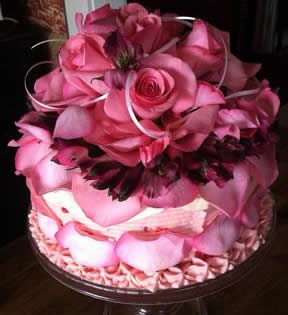
Champagne cake with
maraschino frosting
My passion for cooking rankled her anyway and she frequently liked to mention how “weird” or “gross” she found my vegetarian diet. This isn’t terribly surprising: once when her son suffered kidney stones she nominated the lack of meat in his diet as the cause. I didn’t realize chicken passed through one’s kidneys before I met his family. She refused to sample the cake in my presence, instead shoving it in the refrigerator “for later.” A few days later I received an email thanking me for the “interesting” cake that tasted “almost as good” as a Duncan Hines. She expressed doubt about the buttercream frosting, though, because it had gotten hard in the refrigerator and the kind she bought in a can “never did that.” Nonsensical as it may seem, those rejections soothed us both, shoring up our senses of individual superiority and keeping our worlds distinct. Nevertheless, that was my last culinary offering to the goddess of processed food.
Our final joint project was a memory box, which she announced she wished to create to commemorate her son’s first birthday after his death. He had always admired the Commedia dell’Arte, and Harlequin in particular. I think a major part of the character’s appeal for him was his impishness and sexual fluidity, all of which escaped her. Instead, she opted to focus upon the black-and-white diamond pattern as a motif for our boxes. I spent weeks scouring the internet for images of Harlequin, finding some wonderful copies of 18th century etchings and engravings that I then printed on vellum with the intention of decoupaging them on papier mache boxes we’d purchased at Hobby Lobby. The project took days to complete: we began by painting the boxes white and then creating a diamond-pattern stencil to overlay the white with black. The lids for each box were painted solid black and then we started the painstaking work of cutting out our selected images and creating pleasing collages of them. Once they were just so, we sealed them with several layers of polyurethane. On the inside of my box’s lid, I also decoupaged the last love note I received from him to have as a reminder.
This process proved emotionally challenging, even though it was our first that I found completely satisfying. Creating this box reminded me of the dozens of handmade cards I’d fashioned for him during our time together. I made it a special point to mail these creations to him, hoping to demonstrate the depth of my love by creating objects I considered extensions of myself. This was like creating his final birthday card and even though the experience was neither healing nor transformative, I put myself into it fully because I didn’t know what else to do and I never excelled at sitting and waiting for feelings to pass.
The polyurethane was still tacky the afternoon that we finished, so I left the box in her basement craft room and she promised to deliver it later. It never occurred to me that I shouldn’t have left it with his message pasted under the lid. Later that week I returned home from my second-shift job to find a shopping bag on my front porch. This wasn’t unusual: she frequently left such bags filled with old catalogs or produce out of her parents’ garden—anything to maintain contact. I pretended to hate it, but I secretly appreciated the effort she put forth most of the time.
This time, however, it contained the box. Well, the boxes, actually. Confused about why she had left hers, I looked inside mine to re-read his note and discovered a Post-It stuck on his message: “This box really isn’t my style. You keep it.” I couldn’t create anything that would please her, but perhaps she found value in the process of crafting together. Maybe for her it wasn’t about crafts at all; maybe she just needed a companion.


Memory doll for my grandmother
It’s been over a decade since that moment and during the intervening years, we’ve kept in touch by email. I have moved several times—the last time out of state—so I am no longer able to deliver my outlandish arrangements to the cemetery. I have an arrangement with a local florist, though, and when I’m feeling particularly devilish I have a large bouquet delivered, which maddens her. She always emails to ask if it’s from me, secretly hoping, I think, that some other loved one has emerged to eclipse me, but somehow still appreciating my refusal to disengage. It’s petty and probably not something of which I should be proud, but it’s also my expression of unfailing love and loyalty. He loved that side of me—my larger-than-lifeness—and I imagine him smirking and cackling every time she pulls up and gasps at my hauteur and reckless use of funds. In return, she mails photos of his gravestone at every holiday with a note reminding me how sad it is that she’s the only one who regularly takes flowers there anymore. In some odd way, by each of us constructing the other as a monster with suspect taste, our largely unspoken rivalry sustained and spurred us on—even today, in some small way.
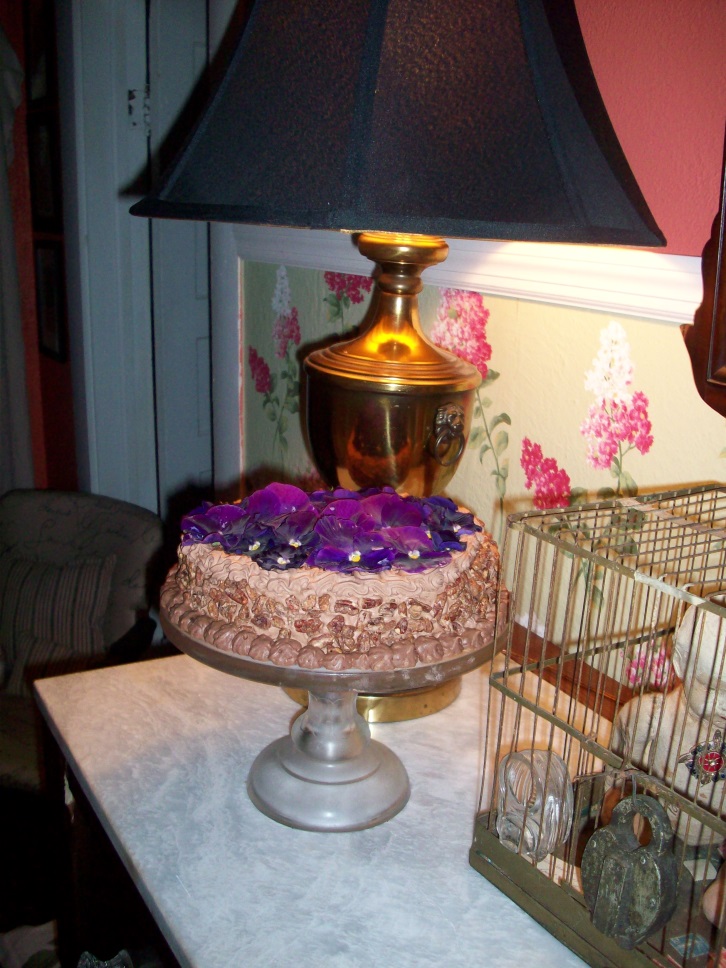
Chocolate cake
For all the crafting that transpired that terrible year, she rarely mentions working on projects of any kind anymore. Occasionally she’ll tell me about the Christmas lights she’s forced into an unsuspecting wine bottle or the power line insulators she’s enslaved as tea-light holders, but largely her desire to craft together appears to have been more about trying to see her son as I did, not about creating anything tangible. As for me, I still make, build, and create whenever possible because engaging in that way helps me feel some sense of satisfaction and power in a world that rarely affords us those securities in any great measure. I occasionally tell her about those projects in emails and she ridicules or diminishes them, and I would be disappointed if she didn’t.
I still make those cakes a few times a year and deliver them to parties or other special events, but I never eat them myself. They recall that winter for me, tugging at its feeling of utter hopelessness coupled with some irritatingly insistent urge to persevere even though I wanted nothing more than to give up. That year taught me to live in that state of horrible tension – joyless and grimly sustaining oneself – and to believe that it would somehow pass. It is the memory of that feeling and the realization that it did pass (or at least changed), but not in a positive-thinking-will-save-you or even some creating-beauty-will-rescue-your-soul kind of way, that emerges most readily from this reminiscence.
It was not transcendence craft brought me; it was simply busyness and willfulness melded with the remembrance of the pleasure I derive from showing others up and augmenting my oeuvre of talents that kept me baking, frosting, decoupaging, etc. It still does. So, while my making and creating may not ennoble, transform, or heal, they somehow sustain, if only through distracting me—these days in the form of bread loaves and quirky assemblages—and most days that distraction and a will to create are our best hope for crafting and surviving the life that’s to come.
Afterword
At some point during the first few months after his death, Aaron’s mother said to me “I can’t imagine why he did it. He had such nice things.” The sentence sickened me at the time and it still doesn’t sit well as we approach the thirteenth anniversary of his death. Thinking about it highlights something for me about craft and DIY, though. For her, it seems, the possession of objects is an end in itself. A son may have been one of those possessions.
One of the very first questions she asked moments after telling me she’d found him dead was “Do you know where the Rolexes are?” He had a small collection of them and somehow locating them was quite important to her, as though they were integral to his being. Making things was always second best for her, apparently even when it came to the creation of another life. She readily prefers store-bought and new and draws a sense of safety and achievement from possessing items like a Mercedes CLK that she carefully hoards in her garage and rarely ever drives or the Rolexes she finally found which now reside in a safe, never seeing day’s light.
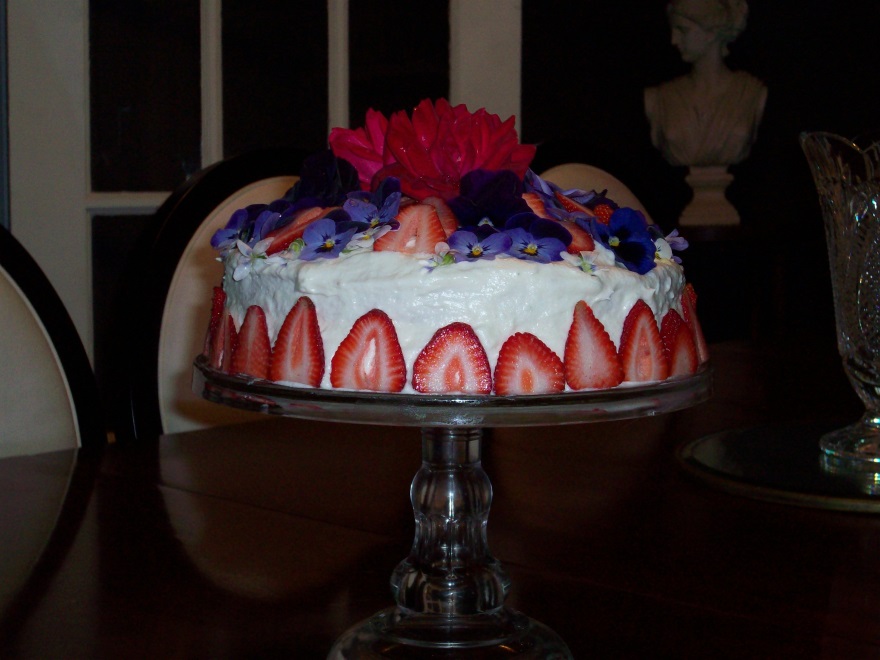
Shortcake with flowers
For me, however, and perhaps this is no less sad or at least no more productive, I would rather create if I can. It distinguishes me and makes me feel I’ve created the world around me, at least in my own home. I genuinely appreciate beauty and I make objects because I view them as representations of who I conceive myself to be. I give them to others as physical manifestations of sincere feeling. As such, they foster a sense of power, efficacy, and mastery in me – feelings I find indispensable for survival in a life that sometimes, no matter how hard one tries or loves, cruelly strips away most of what one truly considers essential to existence.
Joshua Adair avidly collects, renovates, decorates, and cooks when he isn't working as an associate professor of English at Murray State University. He obsesses over rearranging furniture, stalking flea market finds, and making sure the house he shares with his partner, Brad Simmons, stands perennially photo shoot-ready should a design blogger or magazine editor surreptitiously appear and demand entrance. He considers Eddie Ross his archrival; courts all things queer, quirky, and quaint; and hopes to be a pre-incarceration Martha Stewart when he grows up.